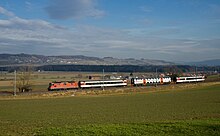Bombardier Double-deck Coach
This article has multiple issues. Please help or discuss these issues on the talk page. (Learn how and when to remove these template messages)
|




The Bombardier Double-deck Coach is a bilevel passenger railcar built by Bombardier Transportation (formerly by Adtranz) used by various European railways and Israel Railways. The current generation of double-deck coaches can be run at speeds up to 200 km/h (125 mph). Depending on their configuration, each coach can seat 100 to 150 passengers.
History[]
The ancestry of these coaches can be traced back to double-deck coaches built by WUMAG at Görlitz for the Lübeck–Büchen–Hamburg railway in 1935. They were push-pull trains with a cab car that could control the steam locomotive at the other end of the train.
After World War II, these coaches were developed further by VEB Waggonbau Görlitz (formerly WUMAG) into double-deck trains of two to five cars sharing bogies. Starting in 1974, single coaches were built again that were the direct ancestors of today's double-deck coaches. These trainsets were used by Deutsche Reichsbahn (East Germany) as well as several other railways of the eastern bloc in large numbers (about 4000). After 1990, VEB Waggonbau Görlitz became part of Deutsche Waggonbau AG (DWA) which was acquired by Bombardier Transportation in 1998.
First Generation[]
Build years 1973–1974 and 1976–1991, sold to East Germany, Bulgaria, Poland, Romania, Czechoslovakia.

| DB class | Vmax | count | UIC type | notes |
|---|---|---|---|---|
| 777 | 120 | DABbuzf | cab car | |
| 778 | 140 | DABbuzf | cab car |
Second Generation[]
Build years 1992-1993 for Germany (Deutsche Reichsbahn and Deutsche Bundesbahn), later named .

| DB class | Vmax | count | UIC type | notes |
|---|---|---|---|---|
| 760 | 140 | 100 | DABbuzf | cab car |
Third Generation[]
Built between 1994 and 1997 under the DWA brand for Germany's (Deutsche Bahn).

| DB class | Vmax | count | UIC type | notes |
|---|---|---|---|---|
| 761 | 140 | 58 | DABbzf | cab car |
| 762 | 140 | 31 | DABpbzf | cab car |
Fourth Generation[]
Built since 1997 and sold under the Bombardier brand to railways in Germany, Denmark, Israel and others.

| German national railways | ||||
|---|---|---|---|---|
| DB class | Vmax | count | UIC type | notes |
| 763 | 160 | 50 | DABpbzf | cab car (originally 140 km/h) |
| 764 | 140 | 39 | DABpbzf | cab car |
| 765 | 160 | 55 | DABpbzfa | cab car (originally 160 km/h) |
| 766 | 160 | 55 | DABpbzfa | cab car |
| 767 | 160 | DABpbzfa | cab car | |
| Luxembourg National Railway Company | ||||
| Class | Vmax | count | UIC type | notes |
| Dosto | 160 | 20 | cab car | |
| 15 | first/second class car | |||
| 52 | second class car | |||
| Danish State Railways | ||||
| Class | Vmax | count | UIC type | notes |
| ABs | 160 | 25 | Cab car; First/second class car with room for bicycles | |
| B | 62 | Second class car | ||
| Bk | 26 | Second class car with vending machine | ||
| Israel Railways | ||||
| Class | Vmax | count | UIC type | notes |
| PC-103 | 140
(later upgraded to 160) |
24 | Driving- and generator trailer | |
| 7 | ||||
| TC-101 | 68 | second class car | ||
| 18 | ||||
| 82 | ||||
| ? | 160 | 78 | Ordered in 2010 | |
| ? | 160 | 72 | Ordered in 2012 | |
Fifth Generation[]



In 2008 Bombardier presented the "Dosto 2010" future family of double-deck trains for the German market. For international sales they were branded as Bombardier TWINDEXX with a "Vario" concept (then called TWINDEXX Vario) that allows these trains to be built for regional or intercity connections with a design speed of 189 km/h and an operational speed of up to 160 km/h. The high-speed rail versions are branded TWINDEXX Express, designed for 230 km/h. A tilting variant of the Twindexx with an operational speed of up to 200 km/h is developed for the Swiss Federal Railways named SBB RABe 502, informally called TWINDEXX Swiss Express. Orders have been placed in the range of a few hundred coaches of the different variants with their initial delivery expected to be during 2015–2017, depending on the variant.
The National Railway Company of Belgium (NMBS/SNCB) has similarly ordered TWINDEXX-derived intercity trains designated as M7 in 2018, constructed at the former BN factory at Bruges, which entered service in January 2020.
In 2007, the Mazovian Railways signed a contract for the delivery of 37 Twindexx Vario wagons (11 steering and 26 trailing wagons). The centre wagons were delivered in August and the steering wagons in December 2008. Initially, the wagons were pulled by EU07 locomotives. The wagons are currently operated by the Mazovian Railways together with TRAXX P160DC locomotives.[1]
Israel Railways ordered 60 in 2016, 33 in 2017, 48 in late 2017 (electric only) and 74 in May 2019.
References[]
| Wikimedia Commons has media related to Bombardier Double-deck Coach. |
- ^ "Koleje Mazowieckie oraz Bombardier Transportation podpisały umowę na serwis utrzymania floty wagonów piętrowych". Koleje Mazowieckie (in Polish). 2012-03-29. Retrieved 2020-11-13.
External links[]
- Bombardier Transportation rail vehicles
- Railway coaches of Denmark
- Railway coaches of Germany
- Railway coaches of Israel
- Railway coaches of Switzerland
- Double-decker rail vehicles